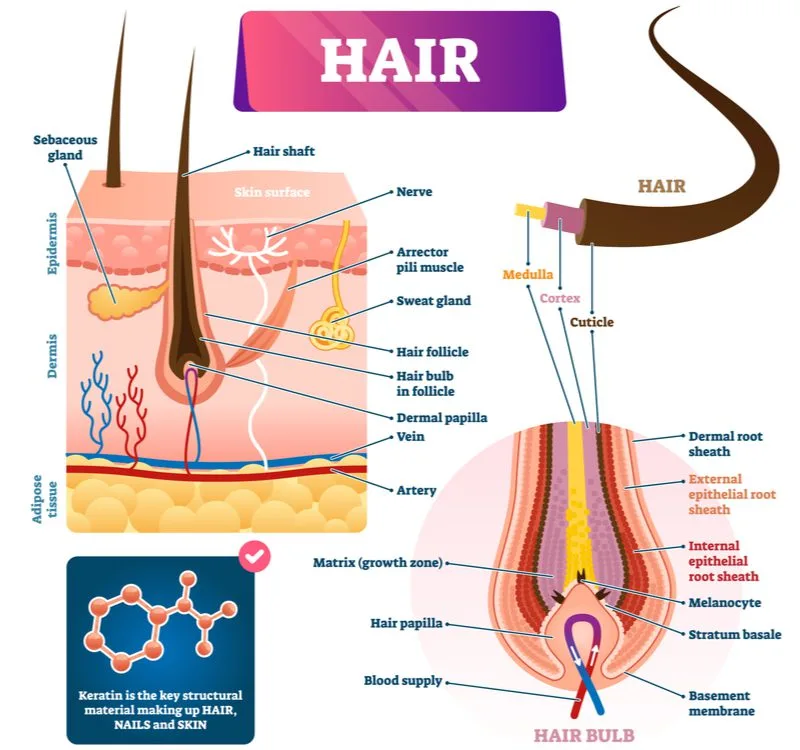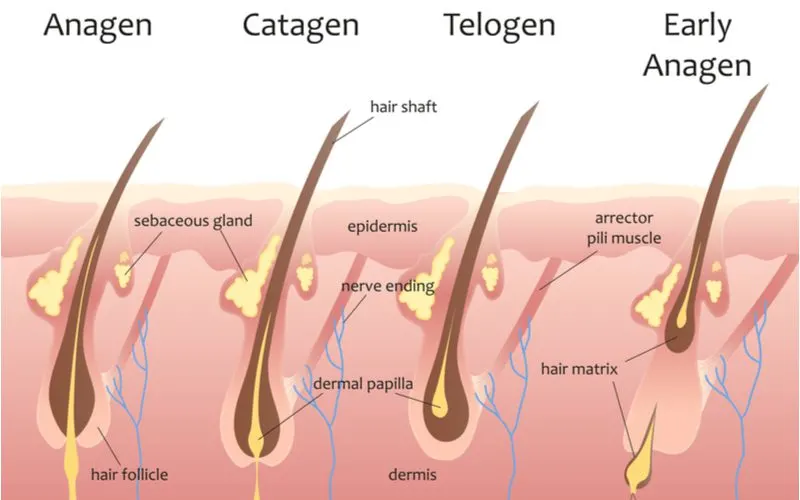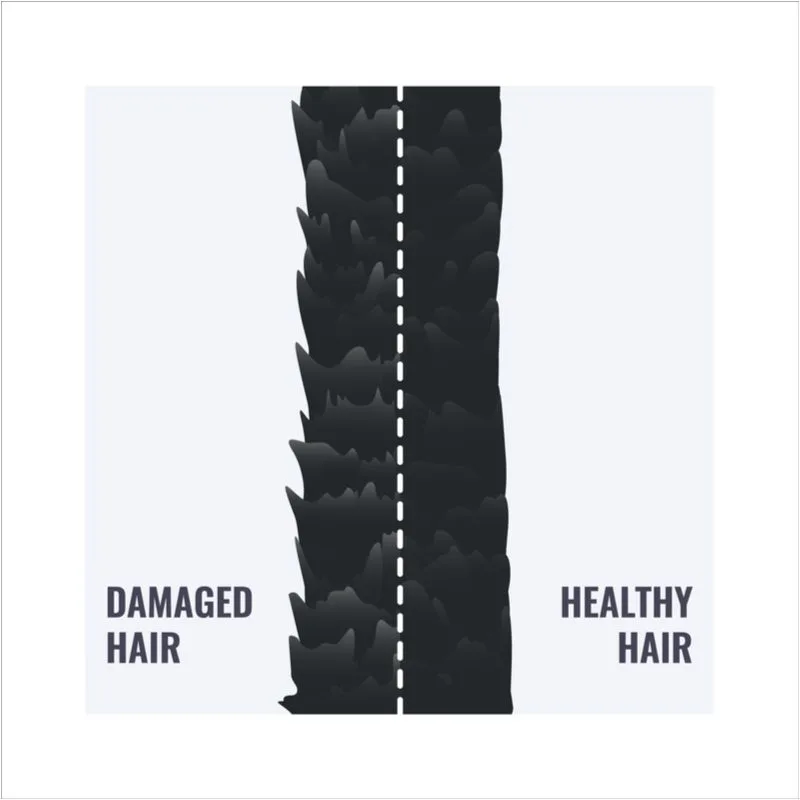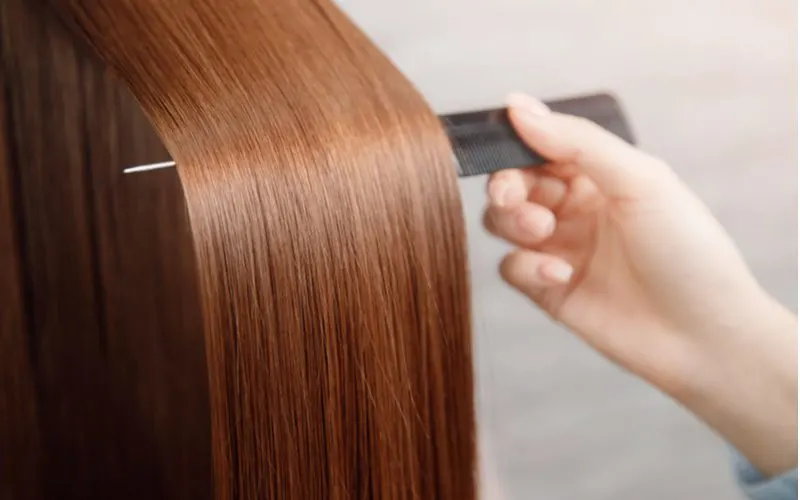Jump to:
What is hair made of? And how exactly does it grow? Most people have never had to ask this question. But if you’re one of the inquisitive few, you’re in the right place. Read on to learn all you need to know.
What Exactly Is Hair?
Ever looked in the mirror while attempting to tame a headful of unruly hair and, surprisingly, wondered what hair is made of? If so, you’re not alone.
Everybody has hair, but very few people understand what it is, how it grows, and the properties it possesses that allow it to be manipulated into many different stylish ‘dos.
Hair is just hair, right? Not quite.
Just like your skin is made up of layers of individual cells, which are themselves composed of water, proteins, lipids, and various other substances, there’s a lot more to hair than meets the eye. A single strand of hair contains:
- Proteins
- Water
- Natural oils
- Trace amounts of chemicals and minerals
And that’s just a general breakdown. If you were inclined, you could split each of these components up into multiple smaller parts, all the way down to the atomic level.
What Is Hair Made Of?

VectorMine/Shutterstock
The main ingredient of hair is a protein called keratin.
Keratin is a strong yet supple protein type distinguished by its unique helical (spiral) shape. The specialized structure of keratin molecules enables them to form lock-tight bonds with one another, giving the resulting filament-like growth a high degree of strength and durability.
But its wonders don’t stop there. Keratin is also water-insoluble, meaning it can get wet without damage or deterioration (that should come as a relief to those of you who shower religiously).
And while the scale-like outer surface of keratin strands (more commonly referred to as “hair”) makes it tough and rigid, it also allows it to remain flowy and flexible, not unlike a jointed suit of armor.
Your hair is almost entirely keratin—95%, to be precise. If it weren’t, it’s safe to say that it wouldn’t be able to hold up to everything you put it through on a daily basis.
It’s thanks to keratin’s resilience that you can sleep on your hair, drench it in the shower, lather it with weird chemicals, style it with intense heat, have it soaked by the rain and blown about by whipping winds, crush it under a hat, soak it with sweat at the gym, and still come home with it intact the same evening.
It kind of makes you wish your whole body were made of the stuff, doesn’t it? Luckily for you, a substantial proportion of it is. Keratin isn’t just found in hair—it’s also part of the makeup of other major bodily tissues, such as your skin, nails, and the lining of your organs and glands.
Needless to say, keratin is kind of a big deal.
How Does Hair Grow?

Lembmerg Vector Studio/Shutterstock
Great question.
Many people believe that hair is “dead” and made up of inert, lifeless cells. While this is partially true (more on that in a moment), it naturally makes them wonder how it can get longer and grow back repeatedly after being sliced off with scissors.
Hair grows and sheds on a cyclical schedule made up of four major growth stages: anagen, catagen, telogen, and early anagen. For the majority of time, your hair strands are in the anagen stage, which means they’re actively growing about 1/2 inch per month. This stage lasts 3-5 years. After this stage, they go into a super-short dormant stage, lasting about 10 days. This is the catagen stage, during which the structures within your hair follicle are shrinking and disconnecting.
Once your hair has disconnected from the structures that nourish it, the telogen (shedding) stage begins. About 10-15% of your hair is in this stage at any given time. It’s why you see hair in the shower, in your hairbrush, and on the counter after you blow dry. After this stage, a new hair starts to form and the early anagen stage begins.
To understand the biological mechanisms responsible for hair growth, it’s necessary to understand a little more about hair structure and its relationship to the rest of the body.
1. The Follicle
Hair follicles are tubelike microstructures (organs, if you want to get technical) in the skin that regulate and support hair growth. You can think of them as tiny factories that manufacture hair strands out of individual keratin molecules. Every hair on your body sprouts from a follicle the way a flower sprouts from a root.
2. The Papilla
Underlying each hair follicle, there’s what’s known as a “papilla,” a kind of intermediary structure that links the hair to surrounding nerves and blood vessels. The papilla contains lots of capillaries that circulate nutrient-rich blood through the follicle. These nutrients serve as the raw materials from which hair is synthesized.
3. The Bulb
The bulb is the base of the hair follicle. It connects directly to the papilla. Contrary to popular belief, this part of the hair is very much alive. In fact, its whole job is to oversee the production and division of cells, which is what causes the hair to grow.
And it does this job very efficiently. The bulb keeps hair-producing cells on track to divide roughly every 23-72 hours — lightning-quick compared to the body’s other cells.
4. The Bulge
The hair bulge is located above the bulb and below the sebaceous gland, which sits just below the epidermis, waiting to coat each strand of hair with a protective oil called sebum, before it makes its way out of the skin.
The bulge is a non-replicating section of hair that stores stem cells, which are like “blank” cells that can be designated for different uses. Most of the time, they’re used by keratinocytes, or cells specially designed to build keratin.
5. The Shaft
The shaft is the visible part of the hair that protrudes from the skin once the ever-lengthening chain of keratin molecules becomes long enough to outgrow the follicle.
If you could cut the shaft in half, you’d find two concentric protein layers called “sheaths.” The inner sheath helps give each strand its long, tubular shape, while the exterior shaft reinforces and protects it.
Things to Consider

art4stock/Shutterstock
Now that you have a better idea of what hair is and how it functions, you’re probably curious whether there’s anything you can do to give it some assistance. The good news is there are several ways to keep your body cranking out fresh keratin and therefore keep your hair strong and healthy.
- Eating more foods that contribute to keratin production, like salmon, eggs, sweet potatoes, carrots, onions, kale, garlic, mangoes, and sunflower seeds
- Supplementing with vital micronutrients that have been shown to have a positive effect on hair growth, such as vitamins A-E, iron, and zinc
- Ditching hygiene and styling products containing the most common culprits of hair damage: sulfates, parabens, alcohol, formaldehyde, and artificial fragrances
- Allowing your hair to dry completely before brushing or styling it to prevent unnecessary stress and breakage
- Doing your best to minimize stress, which if not kept in check can impact the quality and quantity of your hair
Read Next: How to Make Your Hair Grow Faster
Frequently Asked Questions
There’s far more to the science of hair growth than we can cover in a brief article. Hopefully, these answers to common hair-related questions will satisfy some of your lingering curiosity.
Is Hair Dead?
Sort of. Your hair itself is made up of long strands of fibrous keratin molecules, which aren’t themselves alive. However, the hair is generated through the synergy of the papilla, bulb, and bulge, containing living cells.
Will Taking Keratin Help My Hair Grow?
Not necessarily. Your body creates the keratin it needs to make hair using amino acids, water, and a few other minerals and compounds. You can get all of these things from whole foods.
That said, it won’t hurt to try. Many people have noticed a major improvement in the health of their hair after getting on a keratin supplement or making a point of consuming more keratin-promoting foods.
How Is Hair Type Determined?
Hair type is the result of genetics. More specifically, the particular combination of genes your parents passed on to you dictated the shape of your hair follicles, which in turn influences the thickness and texture of your hair strands. Unfortunately, there’s no way to change your hair type. You’re better off learning to love it.
Does Hair Have Bones?
You’re kidding, right? No, it does not have bones.
So, What Is Hair?

Parilov/Shutterstock
So, what is hair made of? Hair is long strands of keratin protein produced by cells that divide and replicate non-stop. Eventually, these strands accumulate into a fluffy mass that keeps the head warm and provides a layer of cushioning that helps safeguard the scalp.
In other words, your hair isn’t just there to look nice—it’s looking out for you. Make sure you’re returning the favor.
